How the Recycling Center Works
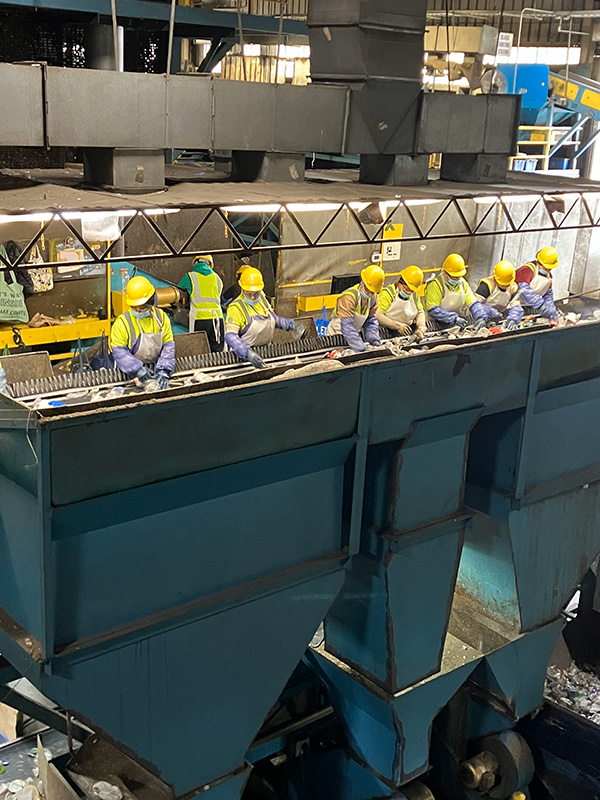 The 57,000 square foot Montgomery County Recycling Center sits on approximately nine acres of land on Route 355, just south of Shady Grove Road. The facility is near the County's Solid Waste Transfer Station.
The 57,000 square foot Montgomery County Recycling Center sits on approximately nine acres of land on Route 355, just south of Shady Grove Road. The facility is near the County's Solid Waste Transfer Station.
Construction of an approximately 7,000 square foot addition to the Recycling Center's tip floor was completed in November 2001. The addition, which was added to the west side of the existing building, provides more area for receipt of commingled material and allows for more flexibility in operating the Recycling Center. The addition also accommodates the ability to handle more material as the population of the County continues to grow. A new processing system was installed in Summer 2002.
The Recycling Center plays an important role in the recycling system. It makes recycling easier for residents. You don't have to sort your glass, cans and plastic bottles because the Recycling Center does it for you.
After you put your recyclables at the curb, the recyclables are collected and brought to the Recycling Center. Here, glass, cans and plastic bottles are inspected, sorted, baled and trucked to mills and plants where the recycled material is made into something new. Waste paper is shipped to paper recyclers. Yard trim is collected and then composted at the Montgomery County Compost Facility.
Because the recyclables are used as raw material for new products, they must be free of any contaminating material. That's why it's so important for residents to know and follow the guidelines for preparing recyclables.
Once recyclable materials are made into new products, then it is up to you again. To complete the recycling process, buy products made with recycled materials. That closes the recycling loop!
Tipping Floor
Recycling collection trucks unload glass, plastic, steel and aluminum containers onto the tipping floor.
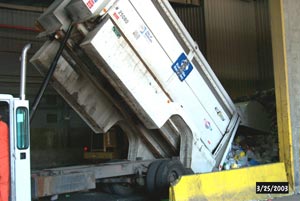
The trucks also unload mixed paper.

Front-end loaders then push the commingled materials onto a conveyor belt that leads to the processing area. The materials then fall onto an inclined conveyor that carries them to the pre-sort station.
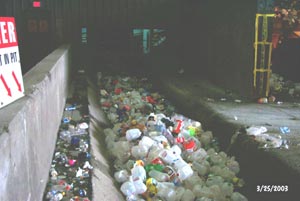
Pre-sort Station
At the pre-sort station, workers remove non-recyclable items as trash. They take out aluminum foil, paper, and large plastic containers for recycling. Sorters also divert PET thermoform packaging (e.g., plastic clamshells), plastic flower pots, and plastic pails and buckets for sorting at other stations.
Recyclables continue to move along on conveyors to various stations as follows:
-
Under an electromagnet, to remove steel, tin and bimetal cans, which are conveyed to a storage silo;
-
Onto a vibrating screen which catches small bits of broken glass that are too small to be sorted;
-
Through a trommel (a steel frame with a spinning screen) which catches bits of paper, broken glass, and bottle caps not previously captured. A magnet removes cans missed by the electromagnet in Step 1;
-
Into the Air Classifier, which pushes the aluminum and plastic upwards by air currents, and then into the Cyclone, where they are separated from the air stream and go to Light Item Sorting. Heavier items (unbroken and large glass pieces) fall to the bottom.
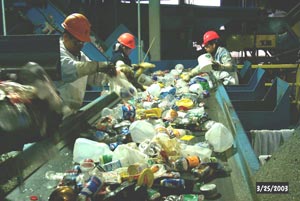
Light Item Sorting
Workers sort plastic by type and drop each into tubes where currents from air blowers propel the material into storage silos.
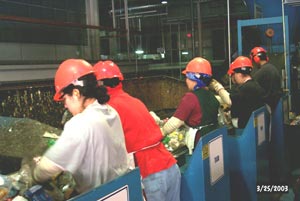
Aluminum passes over an eddy current magnet that causes the cans to have magnetic charges that repel each other. See the cans "POP" off the line over a divider onto connecting conveyors. Material other than aluminum cans falls on the short side of the divider onto a separate conveyor. Additional sorting of recyclables in this material occurs on a conveyor directly below the light item sorting conveyor.
Cans continue on conveyors that lead to a tube where air current moves the cans to a storage silo.
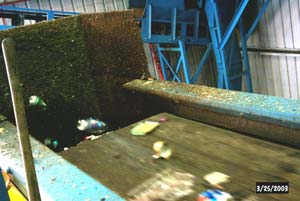
The Blower System
The vertical tubes, and the chutes on top of them, move plastic, once sorted, to storage silos via air pressure.
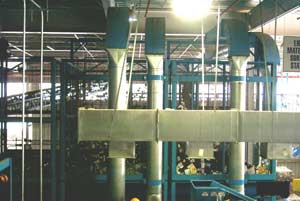
Once sorted, aluminum, plastic and steel are stored separately in silos until they are to be baled.

Glass Sorting
Conveyors take the unbroken and large glass pieces to a sorting station where green, brown, and clear glass is dropped into separate bunkers for storage until being sent to a processor.
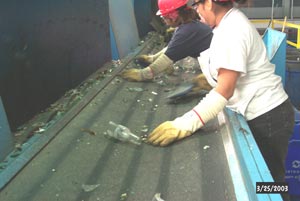
The Blower System
Non-recyclable material (residue) is conveyed to a compactor and taken to the Transfer Station for disposal.
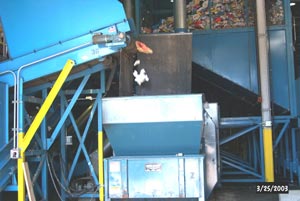
Balers
Balers compress plastic, steel and aluminum containers into a large block, called a bale. Baled materials are sent to processors to be remade into new products. (Glass is not baled, and is loaded onto trailers for its journey to market.)
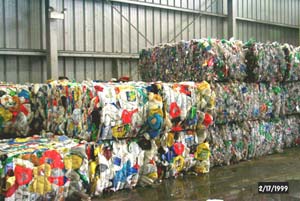
Recycling Center Tours
Schedule a TourAddress
16105 Frederick RoadDerwood, MD 20855